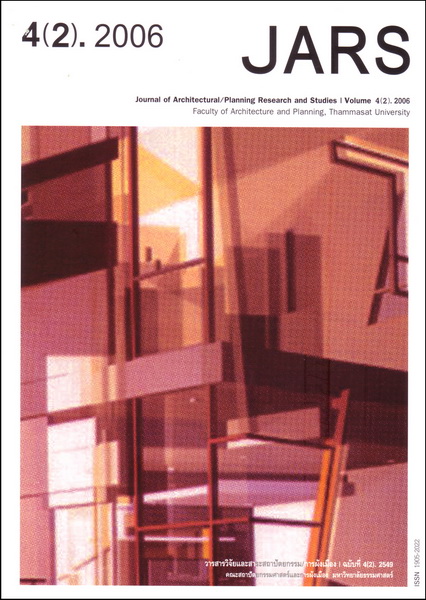Housing Standard Certification by The National Housing Authority
Main Article Content
Abstract
This paper adapted from the quantitative research, Housing Standard Certification by the National
Housing Authority. Its goal pointed to the role of the National Housing Authority about housing standard that
is concerned with housing standard problem complaints, housing standard certification principles and
criteria, advantages and disadvantages by the National Housing Authority, and guidelines for housing standard
certification. The questionnaire was distributed to 2,083 people of every region: Bangkok, Suphan Buri,
Nakhon Pathom, Ratchaburi, Chiang Mai, Songkhla, Chon Buri, Khon Kaen, and Nakhon Ratchasima. An
evaluation checklist was given to experts, and brainstorming method was used by stakeholders. The findings
were as follows:
1. Housing standard problem complaints are received by the information service of the National
Housing Authority and the Office of the Consumer Protection Board. The complaints are primarily concerned
with physical and environment standards (exterior and interior of the house including structure and building
components, land use, infrastructures, and surroundings) and management standards (facility and
infrastructures management).
2. Housing standard certification principles and criteria are used for controlling and monitoring
housing and services to protect consumers, communities, and environment. The principles deal with size
and form decreasing, agreement, practicality, modernity, necessity, and generality.
3. Advantages by the National Housing Authority include a complete database, legal issues, and
feasibility. Disadvantages include complicated management structure and people’s attitude towards ‘management
transparency’ of the National Housing Authority.
4. Guidelines for housing standard certification consist of 1) law and act guideline: for controlling
and industrial standard 2) management guideline: under facility management system and law system 3)
physical guideline: under public standard adaptation, the National Housing Authority’s standard, and public
organization standard. Theoretical propositions show that the roles of housing standard certification are
concerned with five standards: environment and housing environment, building, facility management, safety,
and planning. Thus, the certificator must support and promote standardized organizations or developers,
and disseminate knowledge and methods of problem solving to people/stakeholders.
Downloads
Article Details

This work is licensed under a Creative Commons Attribution-NonCommercial-NoDerivatives 4.0 International License.
All material is licensed under the terms of the Creative Commons Attribution 4.0 International (CC-BY-NC-ND 4.0) License, unless otherwise stated. As such, authors are free to share, copy, and redistribute the material in any medium or format. The authors must give appropriate credit, provide a link to the license, and indicate if changes were made. The authors may do so in any reasonable manner, but not in any way that suggests the licensor endorses you or your use. The authors may not use the material for commercial purposes. If the authors remix, transform, or build upon the material, they may not distribute the modified material, unless permission is obtained from JARS. Final, accepted versions of the paper may be posted on third party repositories, provided appropriate acknowledgement to the original source is clearly noted.
References
กรุงเทพธุรกิจ. (2529). มาตรฐานที่อยู่อาศัยและสิ่งแวดล้อมของการเคหะแห่งชาติ. เอกสารอัดสำเนา. กรุงเทพฯ: กองวิจัยการก่อสร้าง ฝ่ายวิจัยการก่อสร้าง การเคหะแห่งชาติ.
กรุงเทพธุรกิจ. (2538). มิติใหม่ของการพัฒนาคนจนในเมืองในช่วงแผนพัฒนาเศรษฐกิจและสังคมแห่งชาติ ฉบับที่ 8. เอกสาร ประกอบการสัมมนาเชิงปฏิบัติการ สำนักงานคณะกรรมการพัฒนาเศรษฐกิจและสังคมแห่งชาติ สำนักงานพัฒนาชุมชนเมือง
การเคหะแห่งชาติ. การเคหะแห่งชาติ, กระทรวงการพัฒนาสังคมและความมั่นคงของมนุษย์. (2546). โครงการบ้านเอื้ออาทร ระยะ 1 ถึง 3 (ปี 2546- 2547). กรุงเทพฯ: ม.ป.ท.
การเคหะแห่งชาติ. (2547). รายงานกำหนดรายการมาตรฐานที่อยู่อาศัยและสิ่งแวดล้อมของการเคหะแห่งชาติ. กรุงเทพฯ: ม.ป.ท.
การเคหะแห่งชาติ, ฝ่ายจัดการทรัพย์สินและเคหะชุมชน. (2526). กฎหมาย ระเบียบ และความรู้ที่สำคัญในการดูแลชุมชน. กรุงเทพฯ: ผู้ แต่ง.
ทองใหญ่ ทองใหญ่. (2512). มาตรฐานบ้านพักอาศัยราคาถูกสำหรับประเทศไทย. กรุงเทพฯ: ม.ป.ท.
ปุณณภา ไกรสินธุ์. (2536). การบริหารเคหะชุมชนด้านการดูแลชุมชนของการเคหะแห่งชาติ กรณีศึกษาเคหะชุมชนเมืองใหม่ บางพลี. กรุงเทพฯ: สำนักพิมพ์จุฬาลงกรณ์มหาวิทยาลัย.
พิภพ รอดภัย. (2525). ความรู้ทั่วไปเกี่ยวกับการบริหารงานเคหะชุมชน. กรุงเทพฯ: ศูนย์วิชาการที่อยู่อาศัยการเคหะแห่งชาติ.
มานพ พงศทัต. (2526). รวมเรื่องอาคารชุดของประเทศไทย. กรุงเทพฯ: ม.ป.ท.
วิทวัส รุ่งเรืองผล. (2539). โครงการสำรวจความพึงพอใจของผู้ใช้บริการ การเคหะแห่งชาติ. กรุงเทพฯ: ศูนย์วิจัยธุรกิจ คณะ พาณิชยศาสตร์และการบัญชี มหาวิทยาลัยธรรมศาสตร์.
ศิริทิพย์ อุ่นอนุโลม. (2526). ผลของการออกแบบทางด้านกายภาพต่อการดูแลชุมชน. กรุงเทพฯ: การเคหะแห่งชาติ.
คณะสถาปัตยกรรมศาสตร์, จุฬาลงกรณ์มหาวิทยาลัย. (2547). สรุปสาระสำคัญเพื่อจัดทำร่างมาตรฐานที่อยู่อาศัยสำหรับผู้มีรายได้น้อย. กรุงเทพฯ: สำนักพิมพ์จุฬาลงกรณ์มหาวิทยาลัย.
Department of Housing and Urban Development. (2005). Part 3280- Manufactured home construction and safety standards, Chapter XX. Office of Assistant Secretary for Housing Federal Housing Commissioner. Retrieved from http://www.hud.gov.
Gronroos, C. (1990). Service management and marketing. Massachusetts: Lexington Books.
Looy, B. V. (2003). Services management: An integrated approach. New York: Prentice Hall.
McColl-Kennedy. (2003). Services marketing: A managerial approach. New York: McGraw–Hill.
Ministry of Housing and Local Government. (2005). Retrieved from http://www.gksoft.com/gov/en/my.htm.
Onibokun, A. G. (1974). Evaluating consumers’ satisfaction with housing: An application of system approach. AIP Journal, 40.
Smith, W. F. (1971). Housing: The social and economic element. Berkeley: University of California Press.
Soen, D. (1979). Habitability-occupants’ needs and dwelling satisfaction. New York: Ekistics.
The Indonesia Infrastructure Summit 2005. (2005). Housing and settlement, Law of the Republic of Indonesia. Retrieved from http://www.iisummit2005.com/law.htm.
Thomas, H., & Gardner, D. (1983). Strategic marketing and management. New York: John Wiley & Sons.
Urban Redevelopment Authority. (2005). Development control parameters for residual development. Retrieved from http://www.ura.gov.sg.
Verschure, H. (1976). Housing: Concept and ideas. Housing and development. Leuven: University of Leuven.


